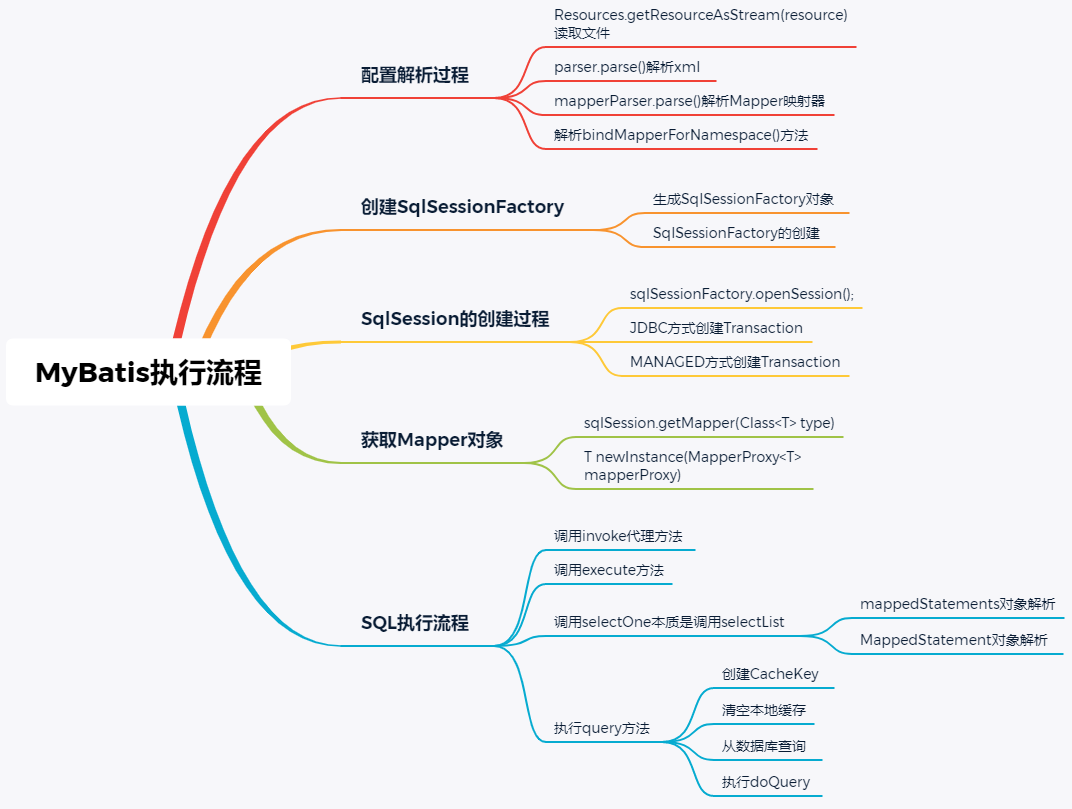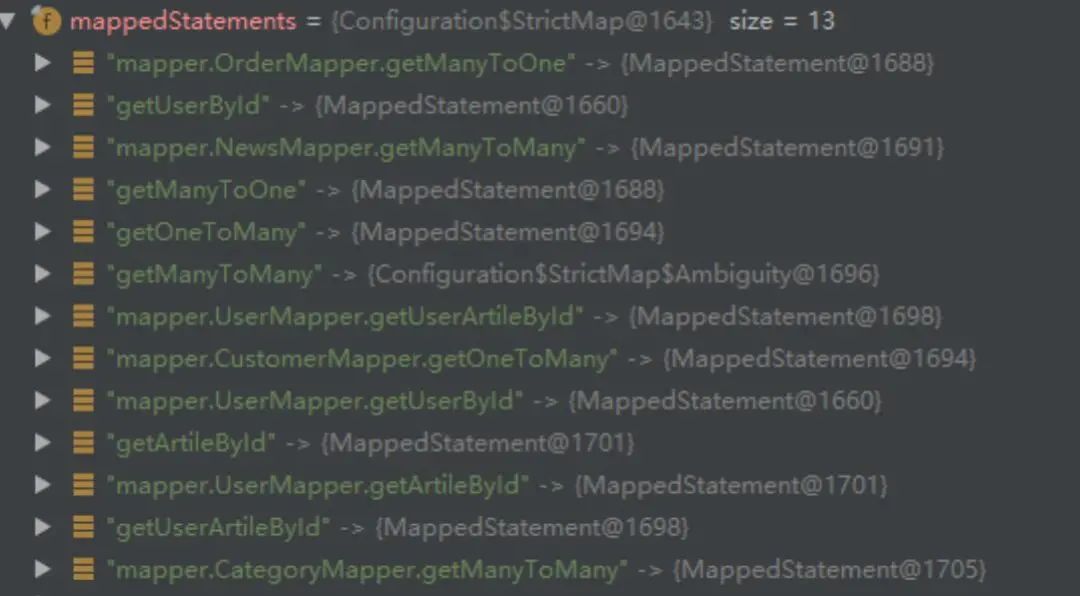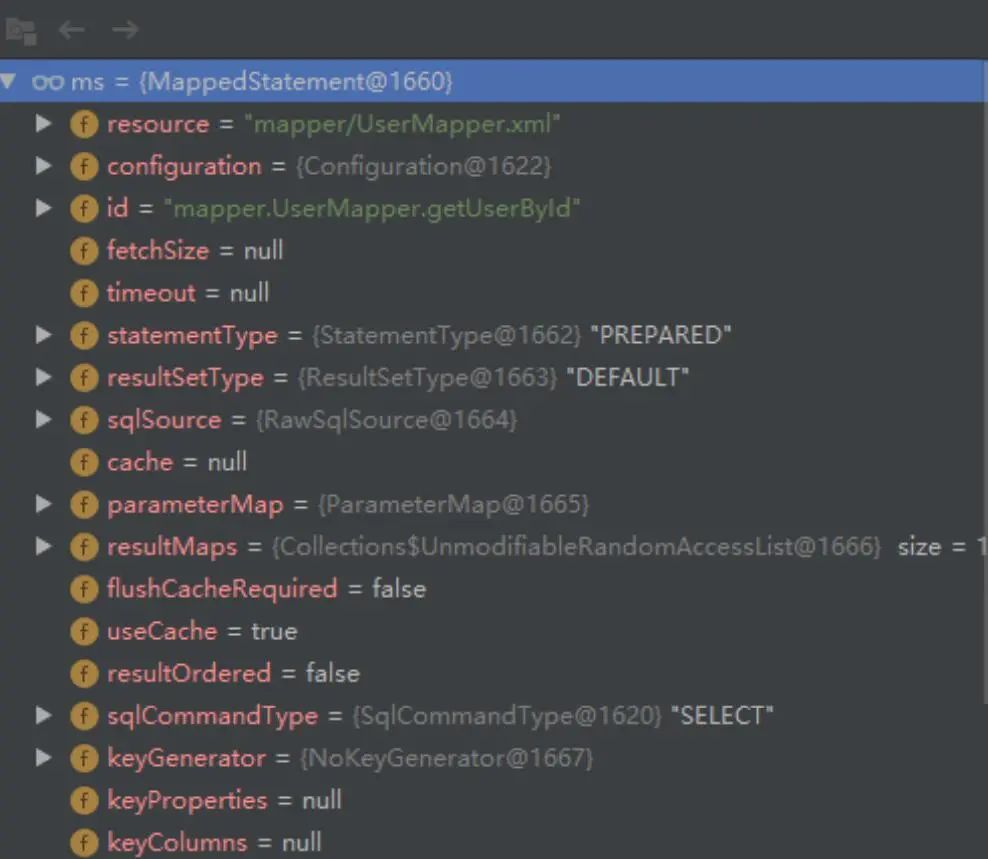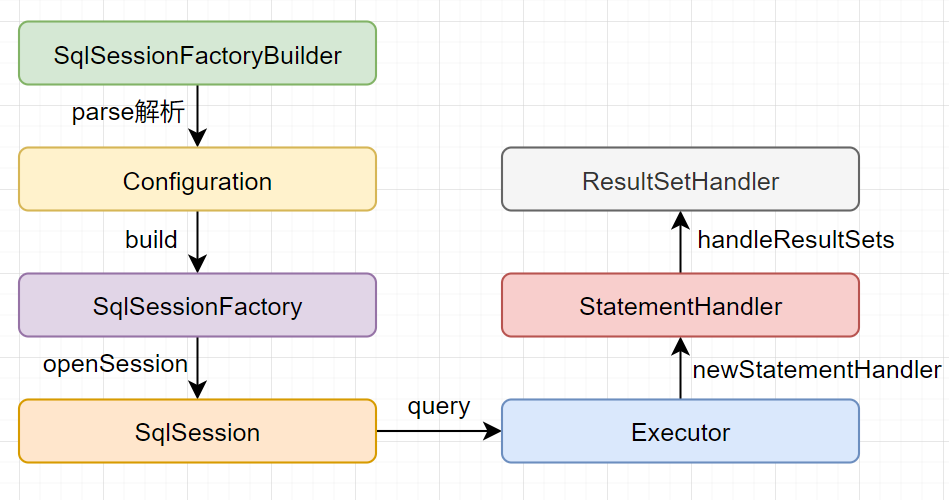# 《面试必问》第02章:聊聊MyBatis执行流程?
大家好,我是冰河~~
随着互联网的发展,越来越多的公司摒弃了Hibernate,而选择拥抱了MyBatis。而且,很多大厂在面试的时候喜欢问MyBatis底层的原理和源码实现。
总之,MyBatis几乎成为了Java开发人员必须深入掌握的框架技术,今天,我们就一起来深入分析MyBatis源码。文章有点长,建议先收藏后慢慢研究。整体三万字左右,全程高能,小伙伴们可慢慢研究。
本文主要结构如下所示。

# MyBatis源码解析
大家应该都知道Mybatis源码也是对Jbdc的再一次封装,不管怎么进行包装,还是会有获取链接、preparedStatement、封装参数、执行这些步骤的。
# 配置解析过程
String resource = "mybatis-config.xml";
//1.读取resources下面的mybatis-config.xml文件
InputStream inputStream = Resources.getResourceAsStream(resource);
//2.使用SqlSessionFactoryBuilder创建SqlSessionFactory
SqlSessionFactory sqlSessionFactory = new SqlSessionFactoryBuilder().build(inputStream);
//3.通过sqlSessionFactory创建SqlSession
SqlSession sqlSession = sqlSessionFactory.openSession();
2
3
4
5
6
7
# Resources.getResourceAsStream(resource)读取文件
public static InputStream getResourceAsStream(String resource) throws IOException {
return getResourceAsStream(null, resource);
}
//loader赋值为null
public static InputStream getResourceAsStream(ClassLoader loader, String resource) throws IOException {
InputStream in = classLoaderWrapper.getResourceAsStream(resource, loader);
if (in == null) {
throw new IOException("Could not find resource " + resource);
}
return in;
}
//classLoader为null
public InputStream getResourceAsStream(String resource, ClassLoader classLoader) {
return getResourceAsStream(resource, getClassLoaders(classLoader));
}
//classLoader类加载
InputStream getResourceAsStream(String resource, ClassLoader[] classLoader) {
for (ClassLoader cl : classLoader) {
if (null != cl) {
//加载指定路径文件流
InputStream returnValue = cl.getResourceAsStream(resource);
// now, some class loaders want this leading "/", so we'll add it and try again if we didn't find the resource
if (null == returnValue) {
returnValue = cl.getResourceAsStream("/" + resource);
}
if (null != returnValue) {
return returnValue;
}
}
}
return null;
}
2
3
4
5
6
7
8
9
10
11
12
13
14
15
16
17
18
19
20
21
22
23
24
25
26
27
28
29
30
31
32
总结:主要是通过ClassLoader.getResourceAsStream()方法获取指定的classpath路径下的Resource 。
# 通过SqlSessionFactoryBuilder创建SqlSessionFactory
//SqlSessionFactoryBuilder是一个建造者模式
SqlSessionFactory sqlSessionFactory = new SqlSessionFactoryBuilder().build(inputStream);
public SqlSessionFactory build(InputStream inputStream) {
return build(inputStream, null, null);
}
//XMLConfigBuilder也是建造者模式
public SqlSessionFactory build(InputStream inputStream, String environment, Properties properties) {
try {
XMLConfigBuilder parser = new XMLConfigBuilder(inputStream, environment, properties);
return build(parser.parse());
} catch (Exception e) {
throw ExceptionFactory.wrapException("Error building SqlSession.", e);
} finally {
ErrorContext.instance().reset();
try {
inputStream.close();
} catch (IOException e) {
// Intentionally ignore. Prefer previous error.
}
}
}
//接下来进入XMLConfigBuilder构造函数
public XMLConfigBuilder(InputStream inputStream, String environment, Properties props) {
this(new XPathParser(inputStream, true, props, new XMLMapperEntityResolver()), environment, props);
}
//接下来进入this后,初始化Configuration
private XMLConfigBuilder(XPathParser parser, String environment, Properties props) {
super(new Configuration());
ErrorContext.instance().resource("SQL Mapper Configuration");
this.configuration.setVariables(props);
this.parsed = false;
this.environment = environment;
this.parser = parser;
}
//其中parser.parse()负责解析xml,build(configuration)创建SqlSessionFactory
return build(parser.parse());
2
3
4
5
6
7
8
9
10
11
12
13
14
15
16
17
18
19
20
21
22
23
24
25
26
27
28
29
30
31
32
33
34
35
36
# parser.parse()解析xml
public Configuration parse() {
//判断是否重复解析
if (parsed) {
throw new BuilderException("Each XMLConfigBuilder can only be used once.");
}
parsed = true;
//读取配置文件一级节点configuration
parseConfiguration(parser.evalNode("/configuration"));
return configuration;
}
private void parseConfiguration(XNode root) {
try {
//properties 标签,用来配置参数信息,比如最常见的数据库连接信息
propertiesElement(root.evalNode("properties"));
Properties settings = settingsAsProperties(root.evalNode("settings"));
loadCustomVfs(settings);
loadCustomLogImpl(settings);
//实体别名两种方式:1.指定单个实体;2.指定包
typeAliasesElement(root.evalNode("typeAliases"));
//插件
pluginElement(root.evalNode("plugins"));
//用来创建对象(数据库数据映射成java对象时)
objectFactoryElement(root.evalNode("objectFactory"));
objectWrapperFactoryElement(root.evalNode("objectWrapperFactory"));
reflectorFactoryElement(root.evalNode("reflectorFactory"));
settingsElement(settings);
// read it after objectFactory and objectWrapperFactory issue #631
//数据库环境
environmentsElement(root.evalNode("environments"));
databaseIdProviderElement(root.evalNode("databaseIdProvider"));
//数据库类型和Java数据类型的转换
typeHandlerElement(root.evalNode("typeHandlers"));
//这个是对数据库增删改查的解析
mapperElement(root.evalNode("mappers"));
} catch (Exception e) {
throw new BuilderException("Error parsing SQL Mapper Configuration. Cause: " + e, e);
}
}
2
3
4
5
6
7
8
9
10
11
12
13
14
15
16
17
18
19
20
21
22
23
24
25
26
27
28
29
30
31
32
33
34
35
36
37
38
总结:parseConfiguration完成的是解析configuration下的标签
private void mapperElement(XNode parent) throws Exception {
if (parent != null) {
for (XNode child : parent.getChildren()) {
//解析<package name=""/>
if ("package".equals(child.getName())) {
String mapperPackage = child.getStringAttribute("name");
//包路径存到mapperRegistry中
configuration.addMappers(mapperPackage);
} else {
//解析<mapper url="" class="" resource=""></mapper>
String resource = child.getStringAttribute("resource");
String url = child.getStringAttribute("url");
String mapperClass = child.getStringAttribute("class");
if (resource != null && url == null && mapperClass == null) {
ErrorContext.instance().resource(resource);
//读取Mapper.xml文件
InputStream inputStream = Resources.getResourceAsStream(resource);
XMLMapperBuilder mapperParser = new XMLMapperBuilder(inputStream,
configuration, resource, configuration.getSqlFragments());
mapperParser.parse();
} else if (resource == null && url != null && mapperClass == null) {
ErrorContext.instance().resource(url);
InputStream inputStream = Resources.getUrlAsStream(url);
XMLMapperBuilder mapperParser = new XMLMapperBuilder(inputStream,
configuration, url, configuration.getSqlFragments());
mapperParser.parse();
} else if (resource == null && url == null && mapperClass != null) {
Class<?> mapperInterface = Resources.classForName(mapperClass);
configuration.addMapper(mapperInterface);
} else {
throw new BuilderException("A mapper element may only specify a url, resource or class, but not more than one.");
}
}
}
}
}
2
3
4
5
6
7
8
9
10
11
12
13
14
15
16
17
18
19
20
21
22
23
24
25
26
27
28
29
30
31
32
33
34
35
36
总结: 通过解析configuration.xml文件,获取其中的Environment、Setting,重要的是将下的所有解析出来之后添加到 Configuration,Configuration类似于配置中心,所有的配置信息都在这里。
# mapperParser.parse()对 Mapper 映射器的解析
public void parse() {
if (!configuration.isResourceLoaded(resource)) {
//解析所有的子标签
configurationElement(parser.evalNode("/mapper"));
configuration.addLoadedResource(resource);
//把namespace(接口类型)和工厂类绑定起来
bindMapperForNamespace();
}
parsePendingResultMaps();
parsePendingCacheRefs();
parsePendingStatements();
}
//这里面解析的是Mapper.xml的标签
private void configurationElement(XNode context) {
try {
String namespace = context.getStringAttribute("namespace");
if (namespace == null || namespace.equals("")) {
throw new BuilderException("Mapper's namespace cannot be empty");
}
builderAssistant.setCurrentNamespace(namespace);
//对其他命名空间缓存配置的引用
cacheRefElement(context.evalNode("cache-ref"));
//对给定命名空间的缓存配置
cacheElement(context.evalNode("cache"));
parameterMapElement(context.evalNodes("/mapper/parameterMap"));
//是最复杂也是最强大的元素,用来描述如何从数据库结果集中来加载对象
resultMapElements(context.evalNodes("/mapper/resultMap"));
//可被其他语句引用的可重用语句块
sqlElement(context.evalNodes("/mapper/sql"));
//获得MappedStatement对象(增删改查标签)
buildStatementFromContext(context.evalNodes("select|insert|update|delete"));
} catch (Exception e) {
throw new BuilderException("Error parsing Mapper XML. The XML location is '" + resource + "'. Cause: " + e, e);
}
}
//获得MappedStatement对象(增删改查标签)
private void buildStatementFromContext(List<XNode> list) {
if (configuration.getDatabaseId() != null) {
buildStatementFromContext(list, configuration.getDatabaseId());
}
buildStatementFromContext(list, null);
}
//获得MappedStatement对象(增删改查标签)
private void buildStatementFromContext(List<XNode> list, String requiredDatabaseId) {
//循环增删改查标签
for (XNode context : list) {
final XMLStatementBuilder statementParser = new XMLStatementBuilder(configuration, builderAssistant, context, requiredDatabaseId);
try {
//解析insert/update/select/del中的标签
statementParser.parseStatementNode();
} catch (IncompleteElementException e) {
configuration.addIncompleteStatement(statementParser);
}
}
}
public void parseStatementNode() {
//在命名空间中唯一的标识符,可以被用来引用这条语句
String id = context.getStringAttribute("id");
//数据库厂商标识
String databaseId = context.getStringAttribute("databaseId");
if (!databaseIdMatchesCurrent(id, databaseId, this.requiredDatabaseId)) {
return;
}
String nodeName = context.getNode().getNodeName();
SqlCommandType sqlCommandType =
SqlCommandType.valueOf(nodeName.toUpperCase(Locale.ENGLISH));
boolean isSelect = sqlCommandType == SqlCommandType.SELECT;
//flushCache和useCache都和二级缓存有关
//将其设置为true后,只要语句被调用,都会导致本地缓存和二级缓存被清空,默认值:false
boolean flushCache = context.getBooleanAttribute("flushCache", !isSelect);
//将其设置为 true 后,将会导致本条语句的结果被二级缓存缓存起来,默认值:对 select 元素为 true
boolean useCache = context.getBooleanAttribute("useCache", isSelect);
boolean resultOrdered = context.getBooleanAttribute("resultOrdered", false);
// Include Fragments before parsing
XMLIncludeTransformer includeParser = new XMLIncludeTransformer(configuration, builderAssistant);
includeParser.applyIncludes(context.getNode());
//会传入这条语句的参数类的完全限定名或别名
String parameterType = context.getStringAttribute("parameterType");
Class<?> parameterTypeClass = resolveClass(parameterType);
String lang = context.getStringAttribute("lang");
LanguageDriver langDriver = getLanguageDriver(lang);
// Parse selectKey after includes and remove them.
processSelectKeyNodes(id, parameterTypeClass, langDriver);
// Parse the SQL (pre: <selectKey> and <include> were parsed and removed)
KeyGenerator keyGenerator;
String keyStatementId = id + SelectKeyGenerator.SELECT_KEY_SUFFIX;
keyStatementId = builderAssistant.applyCurrentNamespace(keyStatementId, true);
if (configuration.hasKeyGenerator(keyStatementId)) {
keyGenerator = configuration.getKeyGenerator(keyStatementId);
} else {
keyGenerator = context.getBooleanAttribute("useGeneratedKeys", configuration.isUseGeneratedKeys() && SqlCommandType.INSERT.equals(sqlCommandType)) ? Jdbc3KeyGenerator.INSTANCE : NoKeyGenerator.INSTANCE;
}
SqlSource sqlSource = langDriver.createSqlSource(configuration, context, parameterTypeClass);
StatementType statementType =
StatementType.valueOf(context.getStringAttribute("statementType",
StatementType.PREPARED.toString()));
Integer fetchSize = context.getIntAttribute("fetchSize");
Integer timeout = context.getIntAttribute("timeout");
String parameterMap = context.getStringAttribute("parameterMap");
//从这条语句中返回的期望类型的类的完全限定名或别名
String resultType = context.getStringAttribute("resultType");
Class<?> resultTypeClass = resolveClass(resultType);
//外部resultMap的命名引用
String resultMap = context.getStringAttribute("resultMap");
String resultSetType = context.getStringAttribute("resultSetType");
ResultSetType resultSetTypeEnum = resolveResultSetType(resultSetType);
String keyProperty = context.getStringAttribute("keyProperty");
String keyColumn = context.getStringAttribute("keyColumn");
String resultSets = context.getStringAttribute("resultSets");
builderAssistant.addMappedStatement(id, sqlSource, statementType, sqlCommandType,
fetchSize, timeout, parameterMap, parameterTypeClass, resultMap, resultTypeClass,
resultSetTypeEnum, flushCache, useCache, resultOrdered,
keyGenerator, keyProperty, keyColumn, databaseId, langDriver, resultSets);
}
public MappedStatement addMappedStatement(
String id,
SqlSource sqlSource,
StatementType statementType,
SqlCommandType sqlCommandType,
Integer fetchSize,
Integer timeout,
String parameterMap,
Class<?> parameterType,
String resultMap,
Class<?> resultType,
ResultSetType resultSetType,
boolean flushCache,
boolean useCache,
boolean resultOrdered,
KeyGenerator keyGenerator,
String keyProperty,
String keyColumn,
String databaseId,
LanguageDriver lang,
String resultSets) {
if (unresolvedCacheRef) {
throw new IncompleteElementException("Cache-ref not yet resolved");
}
id = applyCurrentNamespace(id, false);
boolean isSelect = sqlCommandType == SqlCommandType.SELECT;
MappedStatement.Builder statementBuilder = new MappedStatement.Builder(configuration,
id, sqlSource, sqlCommandType)
.resource(resource)
.fetchSize(fetchSize)
.timeout(timeout)
.statementType(statementType)
.keyGenerator(keyGenerator)
.keyProperty(keyProperty)
.keyColumn(keyColumn)
.databaseId(databaseId)
.lang(lang)
.resultOrdered(resultOrdered)
.resultSets(resultSets)
.resultMaps(getStatementResultMaps(resultMap, resultType, id))
.resultSetType(resultSetType)
.flushCacheRequired(valueOrDefault(flushCache, !isSelect))
.useCache(valueOrDefault(useCache, isSelect))
.cache(currentCache);
ParameterMap statementParameterMap = getStatementParameterMap(parameterMap,
parameterType, id);
if (statementParameterMap != null) {
statementBuilder.parameterMap(statementParameterMap);
}
MappedStatement statement = statementBuilder.build();
//持有在configuration中
configuration.addMappedStatement(statement);
return statement;
}
public void addMappedStatement(MappedStatement ms){
//ms.getId = mapper.UserMapper.getUserById
//ms = MappedStatement等于每一个增删改查的标签的里的数据
mappedStatements.put(ms.getId(), ms);
}
//最终存放到mappedStatements中,mappedStatements存放的是一个个的增删改查
protected final Map<String, MappedStatement> mappedStatements = new StrictMap<MappedStatement>("Mapped Statements collection").conflictMessageProducer((savedValue, targetValue) ->
". please check " + savedValue.getResource() + " and " + targetValue.getResource());
2
3
4
5
6
7
8
9
10
11
12
13
14
15
16
17
18
19
20
21
22
23
24
25
26
27
28
29
30
31
32
33
34
35
36
37
38
39
40
41
42
43
44
45
46
47
48
49
50
51
52
53
54
55
56
57
58
59
60
61
62
63
64
65
66
67
68
69
70
71
72
73
74
75
76
77
78
79
80
81
82
83
84
85
86
87
88
89
90
91
92
93
94
95
96
97
98
99
100
101
102
103
104
105
106
107
108
109
110
111
112
113
114
115
116
117
118
119
120
121
122
123
124
125
126
127
128
129
130
131
132
133
134
135
136
137
138
139
140
141
142
143
144
145
146
147
148
149
150
151
152
153
154
155
156
157
158
159
160
161
162
163
164
165
166
167
168
169
170
171
172
173
174
175
176
# 解析bindMapperForNamespace()方法
把 namespace(接口类型)和工厂类绑定起来
private void bindMapperForNamespace() {
//当前Mapper的命名空间
String namespace = builderAssistant.getCurrentNamespace();
if (namespace != null) {
Class<?> boundType = null;
try {
//interface mapper.UserMapper这种
boundType = Resources.classForName(namespace);
} catch (ClassNotFoundException e) {
}
if (boundType != null) {
if (!configuration.hasMapper(boundType)) {
configuration.addLoadedResource("namespace:" + namespace);
configuration.addMapper(boundType);
}
}
}
}
public <T> void addMapper(Class<T> type) {
mapperRegistry.addMapper(type);
}
public <T> void addMapper(Class<T> type) {
if (type.isInterface()) {
if (hasMapper(type)) {
throw new BindingException("Type " + type + " is already known to the MapperRegistry.");
}
boolean loadCompleted = false;
try {
//接口类型(key)->工厂类
knownMappers.put(type, new MapperProxyFactory<>(type));
MapperAnnotationBuilder parser = new MapperAnnotationBuilder(config, type);
parser.parse();
loadCompleted = true;
} finally {
if (!loadCompleted) {
knownMappers.remove(type);
}
}
}
}
2
3
4
5
6
7
8
9
10
11
12
13
14
15
16
17
18
19
20
21
22
23
24
25
26
27
28
29
30
31
32
33
34
35
36
37
38
39
40
# 生成SqlSessionFactory对象
XMLMapperBuilder.parse()方法,是对 Mapper 映射器的解析里面有两个方法:
(1)configurationElement()解析所有的子标签,最终解析Mapper.xml中的insert/update/delete/select标签的id(全路径)组成key和整个标签和数据连接组成MappedStatement存放到Configuration中的 mappedStatements这个map里面。
(2)bindMapperForNamespace()是把接口类型(interface mapper.UserMapper)和工厂类存到放MapperRegistry中的knownMappers里面。
# SqlSessionFactory的创建
public SqlSessionFactory build(Configuration config) {
return new DefaultSqlSessionFactory(config);
}
2
3
直接把Configuration当做参数,直接new一个DefaultSqlSessionFactory。
# SqlSession会话的创建过程
mybatis操作的时候跟数据库的每一次连接,都需要创建一个会话,我们用openSession()方法来创建。这个会话里面需要包含一个Executor用来执行 SQL。Executor又要指定事务类型和执行器的类型。
# 创建Transaction(两种方式)
| 属性 | 产生工厂类 | 产生事务 |
|---|---|---|
| JDBC | JbdcTransactionFactory | JdbcTransaction |
| MANAGED | ManagedTransactionFactory | ManagedTransaction |
- 如果配置的是 JDBC,则会使用Connection 对象的 commit()、rollback()、close()管理事务。
- 如果配置成MANAGED,会把事务交给容器来管理,比如 JBOSS,Weblogic。
SqlSession sqlSession = sqlSessionFactory.openSession();
public SqlSession openSession() {
//configuration中有默认赋值protected ExecutorType defaultExecutorType = ExecutorType.SIMPLE
return openSessionFromDataSource(configuration.getDefaultExecutorType(), null, false);
}
<environments default="development">
<environment id="development">
<transactionManager type="JDBC"/>
<dataSource type="POOLED">
<property name="driver" value="${driver}"/>
<property name="url" value="${url}"/>
<property name="username" value="${username}"/>
<property name="password" value="${password}"/>
</dataSource>
</environment>
</environments>
2
3
4
5
6
7
8
9
10
11
12
13
14
15
16
# 创建Executor
//ExecutorType是SIMPLE,一共有三种SIMPLE(SimpleExecutor)、REUSE(ReuseExecutor)、BATCH(BatchExecutor)
private SqlSession openSessionFromDataSource(ExecutorType execType, TransactionIsolationLevel level, boolean autoCommit) {
Transaction tx = null;
try {
//xml中的development节点
final Environment environment = configuration.getEnvironment();
//type配置的是Jbdc所以生成的是JbdcTransactionFactory工厂类
final TransactionFactory transactionFactory = getTransactionFactoryFromEnvironment(environment);
//Jdbc生成JbdcTransactionFactory生成JbdcTransaction
tx = transactionFactory.newTransaction(environment.getDataSource(), level, autoCommit);
//创建CachingExecutor执行器
final Executor executor = configuration.newExecutor(tx, execType);
//创建DefaultSqlSession属性包括 Configuration、Executor对象
return new DefaultSqlSession(configuration, executor, autoCommit);
} catch (Exception e) {
closeTransaction(tx); // may have fetched a connection so lets call
close()
throw ExceptionFactory.wrapException("Error opening session. Cause: " + e, e);
} finally {
ErrorContext.instance().reset();
}
}
2
3
4
5
6
7
8
9
10
11
12
13
14
15
16
17
18
19
20
21
22
# 获得Mapper对象
UserMapper userMapper = sqlSession.getMapper(UserMapper.class);
public <T> T getMapper(Class<T> type) {
return configuration.getMapper(type, this);
}
2
3
4
mapperRegistry.getMapper是从MapperRegistry的knownMappers里面取的,knownMappers里面存的是接口类型(interface mapper.UserMapper)和工厂类(MapperProxyFactory)。
public <T> T getMapper(Class<T> type, SqlSession sqlSession) {
return mapperRegistry.getMapper(type, sqlSession);
}
2
3
从knownMappers的Map里根据接口类型(interface mapper.UserMapper)取出对应的工厂类。
public <T> T getMapper(Class<T> type, SqlSession sqlSession) {
final MapperProxyFactory<T> mapperProxyFactory = (MapperProxyFactory<T>)
knownMappers.get(type);
if (mapperProxyFactory == null) {
throw new BindingException("Type " + type + " is not known to the MapperRegistry.");
}
try {
return mapperProxyFactory.newInstance(sqlSession);
} catch (Exception e) {
throw new BindingException("Error getting mapper instance. Cause: " + e, e);
}
}
public T newInstance(SqlSession sqlSession) {
final MapperProxy<T> mapperProxy = new MapperProxy<>(sqlSession, mapperInterface, methodCache);
return newInstance(mapperProxy);
}
2
3
4
5
6
7
8
9
10
11
12
13
14
15
16
这里通过JDK动态代理返回代理对象MapperProxy(org.apache.ibatis.binding.MapperProxy@6b2ea799)
protected T newInstance(MapperProxy<T> mapperProxy) {
//mapperInterface是interface mapper.UserMapper
return (T) Proxy.newProxyInstance(mapperInterface.getClassLoader(), new
Class[] { mapperInterface }, mapperProxy);
}
UserMapper userMapper = sqlSession.getMapper(UserMapper.class);
2
3
4
5
6
# 执行SQL
User user = userMapper.getUserById(1);
# 调用invoke代理方法
由于所有的 Mapper 都是 MapperProxy 代理对象,所以任意的方法都是执行MapperProxy 的invoke()方法
public Object invoke(Object proxy, Method method, Object[] args) throws Throwable {
try {
//判断是否需要去执行SQL还是直接执行方法
if (Object.class.equals(method.getDeclaringClass())) {
return method.invoke(this, args);
//这里判断的是接口中的默认方法Default等
} else if (isDefaultMethod(method)) {
return invokeDefaultMethod(proxy, method, args);
}
} catch (Throwable t) {
throw ExceptionUtil.unwrapThrowable(t);
}
//获取缓存,保存了方法签名和接口方法的关系
final MapperMethod mapperMethod = cachedMapperMethod(method);
return mapperMethod.execute(sqlSession, args);
}
2
3
4
5
6
7
8
9
10
11
12
13
14
15
16
# 调用execute方法
这里使用的例子用的是查询所以走的是else分支语句。
public Object execute(SqlSession sqlSession, Object[] args) {
Object result;
//根据命令类型走不行的操作command.getType()是select
switch (command.getType()) {
case INSERT: {
Object param = method.convertArgsToSqlCommandParam(args);
result = rowCountResult(sqlSession.insert(command.getName(), param));
break;
}
case UPDATE: {
Object param = method.convertArgsToSqlCommandParam(args);
result = rowCountResult(sqlSession.update(command.getName(), param));
break;
}
case DELETE: {
Object param = method.convertArgsToSqlCommandParam(args);
result = rowCountResult(sqlSession.delete(command.getName(), param));
break;
}
case SELECT:
if (method.returnsVoid() && method.hasResultHandler()) {
executeWithResultHandler(sqlSession, args);
result = null;
} else if (method.returnsMany()) {
result = executeForMany(sqlSession, args);
} else if (method.returnsMap()) {
result = executeForMap(sqlSession, args);
} else if (method.returnsCursor()) {
result = executeForCursor(sqlSession, args);
} else {
//将参数转换为SQL的参数
Object param = method.convertArgsToSqlCommandParam(args);
result = sqlSession.selectOne(command.getName(), param);
if (method.returnsOptional()
&& (result == null ||
!method.getReturnType().equals(result.getClass()))) {
result = Optional.ofNullable(result);
}
}
break;
case FLUSH:
result = sqlSession.flushStatements();
break;
default:
throw new BindingException("Unknown execution method for: " + command.getName());
}
if (result == null && method.getReturnType().isPrimitive() && !method.returnsVoid()) {
throw new BindingException("Mapper method '" + command.getName() + " attempted to return null from a method with a primitive return type (" + method.getReturnType() + ").");
}
return result;
}
2
3
4
5
6
7
8
9
10
11
12
13
14
15
16
17
18
19
20
21
22
23
24
25
26
27
28
29
30
31
32
33
34
35
36
37
38
39
40
41
42
43
44
45
46
47
48
49
50
51
# 调用selectOne其实是selectList
selectOne查询一个和查询多个其实是一样的。
public <T> T selectOne(String statement, Object parameter) {
// Popular vote was to return null on 0 results and throw exception on too many.
List<T> list = this.selectList(statement, parameter);
if (list.size() == 1) {
return list.get(0);
} else if (list.size() > 1) {
throw new TooManyResultsException("Expected one result (or null) to be returned by selectOne(), but found: " + list.size());
} else {
return null;
}
}
public <E> List<E> selectList(String statement, Object parameter, RowBounds rowBounds) {
try {
//从Configuration里的mappedStatements里根据key(id的全路径)获取MappedStatement 对象
MappedStatement ms = configuration.getMappedStatement(statement);
return executor.query(ms, wrapCollection(parameter), rowBounds, Executor.NO_RESULT_HANDLER);
} catch (Exception e) {
throw ExceptionFactory.wrapException("Error querying database. Cause: " + e, e);
} finally {
ErrorContext.instance().reset();
}
}
2
3
4
5
6
7
8
9
10
11
12
13
14
15
16
17
18
19
20
21
22
# mappedStatements对象如图

# MappedStatement对象如图

# 执行query方法
# 创建CacheKey
从 BoundSql 中获取SQL信息,创建 CacheKey。这个CacheKey就是缓存的Key。
public <E> List<E> query(MappedStatement ms, Object parameterObject, RowBounds rowBounds, ResultHandler resultHandler) throws SQLException {
//创建缓存Key
BoundSql boundSql = ms.getBoundSql(parameterObject);
//key = -575461213:-771016147:mapper.UserMapper.getUserById:0:2147483647:select * from test_user where id = ?:1:development
CacheKey key = createCacheKey(ms, parameterObject, rowBounds, boundSql);
return query(ms, parameterObject, rowBounds, resultHandler, key, boundSql);
}
public <E> List<E> query(MappedStatement ms, Object parameterObject, RowBounds rowBounds, ResultHandler resultHandler, CacheKey key, BoundSql boundSql) throws SQLException {
Cache cache = ms.getCache();
if (cache != null) {
flushCacheIfRequired(ms);
if (ms.isUseCache() && resultHandler == null) {
ensureNoOutParams(ms, boundSql);
@SuppressWarnings("unchecked")
List<E> list = (List<E>) tcm.getObject(cache, key);
if (list == null) {
list = delegate.query(ms, parameterObject, rowBounds, resultHandler, key, boundSql);
tcm.putObject(cache, key, list); // issue #578 and #116
}
return list;
}
}
return delegate.query(ms, parameterObject, rowBounds, resultHandler, key, boundSql);
}
2
3
4
5
6
7
8
9
10
11
12
13
14
15
16
17
18
19
20
21
22
23
24
# 清空本地缓存
public <E> List<E> query(MappedStatement ms, Object parameter, RowBounds rowBounds, ResultHandler resultHandler, CacheKey key, BoundSql boundSql) throws SQLException {
ErrorContext.instance().resource(ms.getResource()).activity("executing a query").object(ms.getId());
if (closed) {
throw new ExecutorException("Executor was closed.");
}
//queryStack 用于记录查询栈,防止递归查询重复处理缓存
//flushCache=true 的时候,会先清理本地缓存(一级缓存)
if (queryStack == 0 && ms.isFlushCacheRequired()) {
//清空本地缓存
clearLocalCache();
}
List<E> list;
try {
queryStack++;
list = resultHandler == null ? (List<E>) localCache.getObject(key) : null;
if (list != null) {
handleLocallyCachedOutputParameters(ms, key, parameter, boundSql);
} else {
//如果没有缓存,会从数据库查询:queryFromDatabase()
list = queryFromDatabase(ms, parameter, rowBounds, resultHandler, key, boundSql);
}
} finally {
queryStack--;
}
if (queryStack == 0) {
for (DeferredLoad deferredLoad : deferredLoads) {
deferredLoad.load();
}
// issue #601
deferredLoads.clear();
//如果 LocalCacheScope == STATEMENT,会清理本地缓存
if (configuration.getLocalCacheScope() == LocalCacheScope.STATEMENT) {
// issue #482
clearLocalCache();
}
}
return list;
}
2
3
4
5
6
7
8
9
10
11
12
13
14
15
16
17
18
19
20
21
22
23
24
25
26
27
28
29
30
31
32
33
34
35
36
37
38
# 从数据库查询
private <E> List<E> queryFromDatabase(MappedStatement ms, Object parameter, RowBounds rowBounds, ResultHandler resultHandler, CacheKey key, BoundSql boundSql) throws SQLException {
List<E> list;
//先在缓存用占位符占位
localCache.putObject(key, EXECUTION_PLACEHOLDER);
try {
//执行Executor 的 doQuery(),默认是SimpleExecutor
list = doQuery(ms, parameter, rowBounds, resultHandler, boundSql);
} finally {
//执行查询后,移除占位符
localCache.removeObject(key);
}
//从新放入数据
localCache.putObject(key, list);
if (ms.getStatementType() == StatementType.CALLABLE) {
localOutputParameterCache.putObject(key, parameter);
}
return list;
}
2
3
4
5
6
7
8
9
10
11
12
13
14
15
16
17
18
# 执行doQuery
public <E> List<E> doQuery(MappedStatement ms, Object parameter, RowBounds rowBounds, ResultHandler resultHandler, BoundSql boundSql) throws SQLException {
Statement stmt = null;
try {
Configuration configuration = ms.getConfiguration();
StatementHandler handler = configuration.newStatementHandler(wrapper, ms, parameter, rowBounds, resultHandler, boundSql);
stmt = prepareStatement(handler, ms.getStatementLog());
return handler.query(stmt, resultHandler);
} finally {
closeStatement(stmt);
}
}
2
3
4
5
6
7
8
9
10
11
# 源码总结
总体上来说,MyBatis的源码还是比较简单的,只要大家踏下心来,花个两三天仔细研究下,基本上都能弄明白源码的主体脉络。为了方便小伙伴们理解,冰河为大家整理了一个MyBatis整体执行的流程图。

好了,今天就到这儿吧,我是冰河,我们下期见~~
# 星球服务
加入星球,你将获得:
1.项目学习:微服务入门必备的SpringCloud Alibaba实战项目、手写RPC项目—所有大厂都需要的项目【含上百个经典面试题】、深度解析Spring6核心技术—只要学习Java就必须深度掌握的框架【含数十个经典思考题】、Seckill秒杀系统项目—进大厂必备高并发、高性能和高可用技能。
2.框架源码:手写RPC项目—所有大厂都需要的项目【含上百个经典面试题】、深度解析Spring6核心技术—只要学习Java就必须深度掌握的框架【含数十个经典思考题】。
3.硬核技术:深入理解高并发系列(全册)、深入理解JVM系列(全册)、深入浅出Java设计模式(全册)、MySQL核心知识(全册)。
4.技术小册:深入理解高并发编程(第1版)、深入理解高并发编程(第2版)、从零开始手写RPC框架、SpringCloud Alibaba实战、冰河的渗透实战笔记、MySQL核心知识手册、Spring IOC核心技术、Nginx核心技术、面经手册等。
5.技术与就业指导:提供相关就业辅导和未来发展指引,冰河从初级程序员不断沉淀,成长,突破,一路成长为互联网资深技术专家,相信我的经历和经验对你有所帮助。
冰河的知识星球是一个简单、干净、纯粹交流技术的星球,不吹水,目前加入享5折优惠,价值远超门票。加入星球的用户,记得添加冰河微信:hacker_binghe,冰河拉你进星球专属VIP交流群。
# 星球重磅福利
跟冰河一起从根本上提升自己的技术能力,架构思维和设计思路,以及突破自身职场瓶颈,冰河特推出重大优惠活动,扫码领券进行星球,直接立减149元,相当于5折, 这已经是星球最大优惠力度!

领券加入星球,跟冰河一起学习《SpringCloud Alibaba实战》、《手撸RPC专栏》和《Spring6核心技术》,更有已经上新的《大规模分布式Seckill秒杀系统》,从零开始介绍原理、设计架构、手撸代码。后续更有硬核中间件项目和业务项目,而这些都是你升职加薪必备的基础技能。
100多元就能学这么多硬核技术、中间件项目和大厂秒杀系统,如果是我,我会买他个终身会员!
# 其他方式加入星球
- 链接 :打开链接 http://m6z.cn/6aeFbs (opens new window) 加入星球。
- 回复 :在公众号 冰河技术 回复 星球 领取优惠券加入星球。
特别提醒: 苹果用户进圈或续费,请加微信 hacker_binghe 扫二维码,或者去公众号 冰河技术 回复 星球 扫二维码加入星球。
# 星球规划
后续冰河还会在星球更新大规模中间件项目和深度剖析核心技术的专栏,目前已经规划的专栏如下所示。
# 中间件项目
- 《大规模分布式定时调度中间件项目实战(非Demo)》:全程手撸代码。
- 《大规模分布式IM(即时通讯)项目实战(非Demo)》:全程手撸代码。
- 《大规模分布式网关项目实战(非Demo)》:全程手撸代码。
- 《手写Redis》:全程手撸代码。
- 《手写JVM》全程手撸代码。
# 超硬核项目
- 《从零落地秒杀系统项目》:全程手撸代码,在阿里云实现压测(已上新)。
- 《大规模电商系统商品详情页项目》:全程手撸代码,在阿里云实现压测。
- 其他待规划的实战项目,小伙伴们也可以提一些自己想学的,想一起手撸的实战项目。。。
既然星球规划了这么多内容,那么肯定就会有小伙伴们提出疑问:这么多内容,能更新完吗?我的回答就是:一个个攻破呗,咱这星球干就干真实中间件项目,剖析硬核技术和项目,不做Demo。初衷就是能够让小伙伴们学到真正的核心技术,不再只是简单的做CRUD开发。所以,每个专栏都会是硬核内容,像《SpringCloud Alibaba实战》、《手撸RPC专栏》和《Spring6核心技术》就是很好的示例。后续的专栏只会比这些更加硬核,杜绝Demo开发。
小伙伴们跟着冰河认真学习,多动手,多思考,多分析,多总结,有问题及时在星球提问,相信在技术层面,都会有所提高。将学到的知识和技术及时运用到实际的工作当中,学以致用。星球中不少小伙伴都成为了公司的核心技术骨干,实现了升职加薪的目标。
# 联系冰河
# 加群交流
本群的宗旨是给大家提供一个良好的技术学习交流平台,所以杜绝一切广告!由于微信群人满 100 之后无法加入,请扫描下方二维码先添加作者 “冰河” 微信(hacker_binghe),备注:星球编号。

# 公众号
分享各种编程语言、开发技术、分布式与微服务架构、分布式数据库、分布式事务、云原生、大数据与云计算技术和渗透技术。另外,还会分享各种面试题和面试技巧。内容在 冰河技术 微信公众号首发,强烈建议大家关注。

# 视频号
定期分享各种编程语言、开发技术、分布式与微服务架构、分布式数据库、分布式事务、云原生、大数据与云计算技术和渗透技术。另外,还会分享各种面试题和面试技巧。

# 星球
加入星球 冰河技术 (opens new window),可以获得本站点所有学习内容的指导与帮助。如果你遇到不能独立解决的问题,也可以添加冰河的微信:hacker_binghe, 我们一起沟通交流。另外,在星球中不只能学到实用的硬核技术,还能学习实战项目!
关注 冰河技术 (opens new window)公众号,回复 星球 可以获取入场优惠券。

